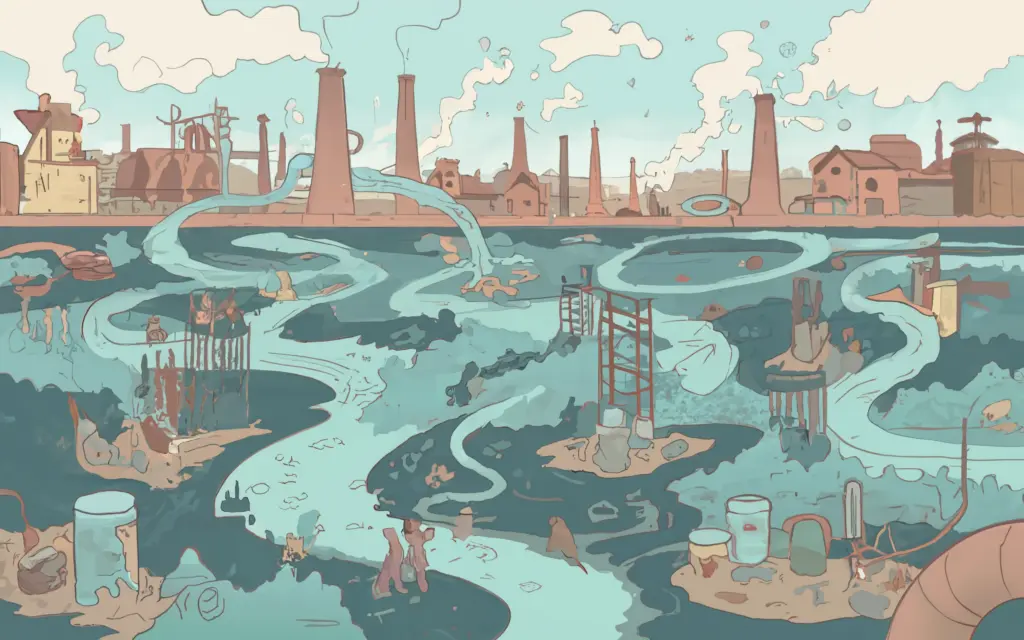The beauty industry is one of the largest sectors in the world, with hair dye products playing a significant role. People use chemical hair dyes to change their appearance, boost their confidence, or express their individuality.
However, the widespread use of these dyes comes with a hidden cost—water pollution.
The Composition of Chemical Hair Dyes
Chemical hair dyes, like those in many popular brands, contain synthetic ingredients such as ammonia, hydrogen peroxide, and aromatic amines that alter hair color.
These chemicals effectively change hair pigment for long-lasting color but come with hidden environmental costs.
When rinsed out, they don’t just disappear—they flow down the drain and enter water systems.
Unlike eco-friendly alternatives like EarthDye, which use natural ingredients, these chemical-laden dyes often bypass wastewater treatment plants, making their way into rivers, lakes, and oceans, contributing to serious water pollution.
Common Chemicals in Hair Dyes and Their Impact
Several harmful chemicals are commonly found in hair dyes:
- Ammonia: Used to open the hair shaft, allowing dye to penetrate.
- Hydrogen Peroxide: A bleaching agent that lightens hair by breaking down its natural pigment.
- Paraphenylenediamine (PPD): A chemical responsible for creating dark shades.
- Resorcinol: Used to achieve vibrant and lasting colors.
These chemicals are not only harsh on hair but also hazardous to the environment, particularly aquatic ecosystems.
How Chemical Hair Dyes Enter Water Systems
The primary way chemical hair dyes enter water systems is through household wastewater. After rinsing dyed hair, the remaining chemicals flow down the drain and into sewage systems.
Unfortunately, many of these chemicals are resistant to standard wastewater treatment processes. This means they eventually end up in natural water bodies.
Hair salons contribute even more significantly to this pollution. With hundreds of clients every day, the runoff from rinsed hair dye adds to the cumulative load of chemical waste in our water systems.
The Long-Term Effects on Aquatic Life
Once in the water, chemical hair dyes can have devastating effects on aquatic ecosystems. Fish, amphibians, and even aquatic plants are vulnerable to the toxic properties of these dyes. Let’s explore some of the long-term consequences.
Toxicity to Fish and Amphibians
Fish are highly sensitive to changes in water quality, and the introduction of toxic chemicals from hair dyes can lead to health issues or death.
Ammonia, for instance, is toxic to fish in even low concentrations. It can cause gill damage, reduce the oxygen-carrying capacity of their blood, and lead to suffocation.
Amphibians like frogs and salamanders, which rely on clean water for survival, are also affected.
Their permeable skin makes them particularly vulnerable to water pollutants. Exposure to these harmful substances can disrupt their reproductive systems, cause developmental abnormalities, and reduce their populations.
Disruption of Aquatic Food Chains
When small aquatic organisms ingest chemicals from hair dyes, the toxins travel up the food chain.
As larger species consume smaller, contaminated organisms, the concentration of harmful chemicals increases. This process, known as bioaccumulation, can result in widespread contamination of an entire ecosystem.
Fish, birds, and mammals at the top of the food chain may suffer from reproductive issues, weakened immune systems, or even death due to the high levels of toxins in their bodies.
Damage to Aquatic Plants
Aquatic plants play a crucial role in maintaining healthy water ecosystems. They provide oxygen, food, and shelter for aquatic animals. However, chemical dyes can affect these plants’ ability to photosynthesize and grow.
The buildup of toxins in water bodies can reduce plant growth, disrupt the balance of ecosystems, and negatively impact the biodiversity of aquatic environments.
Water Quality Degradation
In addition to harming aquatic life, chemical hair dyes also degrade overall water quality. The accumulation of dye chemicals in rivers and lakes can have various effects:
Discoloration of Water Bodies
Many synthetic dyes used in hair products are designed to be resistant to fading, even when exposed to sunlight or washing. When these dyes enter water systems, they can cause noticeable discoloration in rivers and lakes.
This not only affects the aesthetic value of these natural environments but also reduces light penetration in water, which is critical for aquatic plants’ photosynthesis.
Introduction of Harmful Compounds
Chemicals like PPD and resorcinol can form harmful byproducts when they react with other substances in the water.
Some of these byproducts, such as nitrosamines, are known carcinogens. This contamination poses a risk to both wildlife and human populations that rely on these water sources.
Interference with Water Treatment Processes
Many wastewater treatment plants are not equipped to handle the removal of synthetic chemicals like those found in hair dyes.
The presence of these chemicals in water systems can interfere with treatment processes, making it more difficult to produce clean, safe drinking water.
Human Health Risks
The consequences of chemical hair dye pollution extend beyond aquatic ecosystems. Contaminated water can also have serious implications for human health.
Exposure to Toxic Chemicals
Many of the chemicals in hair dyes are known to be harmful to human health. For example, PPD is a potential allergen and can cause skin irritation.
Long-term exposure to water contaminated with dye chemicals could increase the risk of allergic reactions or other health issues, especially for people who come into direct contact with polluted water, such as swimmers or individuals relying on untreated water sources.
Contamination of Drinking Water Supplies
In some areas, untreated or poorly treated wastewater makes its way into drinking water supplies. Even trace amounts of harmful chemicals from hair dyes could accumulate over time, posing a risk to human health.
This is especially concerning in regions where water treatment infrastructure is insufficient to remove complex synthetic compounds.
What Can Be Done to Reduce the Impact?
To address the growing issue of water pollution caused by chemical hair dyes, a combination of individual, industry, and government actions is needed.
Choosing Eco-Friendly Alternatives
One of the simplest ways individuals can reduce their impact is by opting for eco-friendly hair dye alternatives. There are several plant-based and natural dyes available that have fewer harmful chemicals. For example:
- Henna: A natural dye made from the leaves of the henna plant.
- Indigo: A plant-based dye that creates deep, rich shades of blue and black.
- Chamomile: Known for its lightening properties, chamomile can naturally enhance blonde shades.
These alternatives not only reduce water pollution but are also gentler on the hair and scalp.
Salon Wastewater Management
Hair salons, which generate large amounts of chemical waste, can adopt better practices to minimize their environmental impact.
One solution is the use of specialized filtration systems that can capture harmful chemicals before wastewater is released into the public sewage system. Additionally, salons can promote eco-friendly dye brands to their clients, encouraging more sustainable beauty practices.
Improved Wastewater Treatment Technologies
Government and industry leaders must invest in advanced wastewater treatment technologies. Current systems often lack the capacity to effectively remove synthetic chemicals from water.
Enhanced filtration and chemical breakdown processes could reduce the amount of dye pollution entering natural water bodies.
Regulatory Changes
Governments can also play a crucial role in regulating the use of harmful chemicals in beauty products. By setting stricter limits on the types and amounts of chemicals used in hair dyes, policymakers can help reduce the environmental burden of these products.
This may involve banning certain harmful ingredients or promoting the development of biodegradable and non-toxic alternatives.
Raising Public Awareness
Raising public awareness about the environmental impact of chemical hair dyes is essential to driving change. Many consumers are unaware of the hidden consequences their beauty choices have on the environment.
Through education campaigns and eco-labeling, consumers can be encouraged to make more sustainable choices.
Conclusion
The use of chemical hair dyes may seem like a harmless part of everyday life, but the unseen consequences on water pollution are significant. Harmful chemicals in these products threaten aquatic life, degrade water quality, and pose risks to human health.
As awareness of these issues grows, individuals, businesses, and governments must work together to reduce the environmental impact of hair dye pollution.
By choosing eco-friendly alternatives, improving salon wastewater management, and investing in better treatment technologies, we can protect our water systems and create a more sustainable future.

